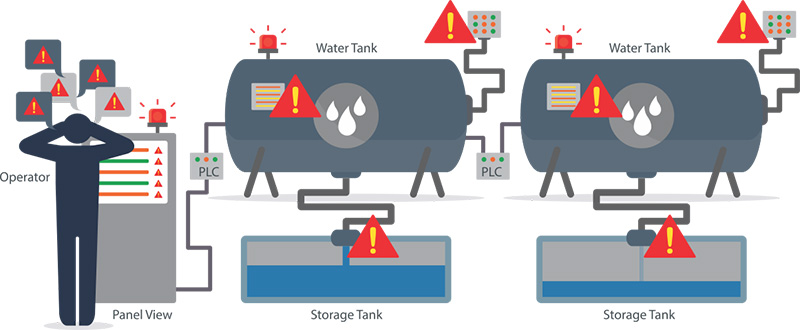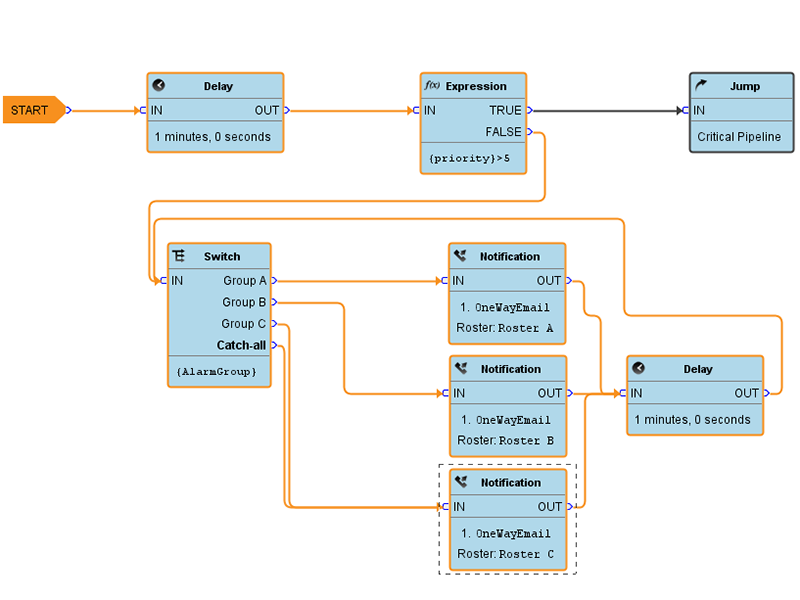How to Avoid Alarm Management Overload with Consolidation and Escalation
Travis Cox, co-director of sales engineering for Inductive Automation, shared some best practices from The Alarm Management Handbook in a webinar titled “Design Like a Pro: Alarm Management.” While the webinar covered a lot of ground in alarm management, this blog post focuses on two techniques that are especially helpful for getting your alarms under control: consolidation and escalation.
Imagine you’re an operator at a water treatment facility.
Your shift has just started and you’ve already been dealing with several alarms. The alarm floods continue as the day goes on, and you notice that many of these alarms are not critical in nature, so you begin to shelve the alarms.
Unfortunately, this causes you to miss a critical alarm which warns that a tank has reached a hazardous pressure level.

This scenario is all too common since a typical industrial organization has hundreds or thousands of alarms in place.
As an operator, you want to be notified of important issues or potential threats to your plant floor. At the same time, getting hundreds or thousands of alarm notifications is not something you want throughout your day.
When the number of alarm notifications becomes overwhelming, operators tend to ignore them, negating the purpose of alarms altogether. This is why managing your alarms is incredibly important.
Consolidating Your Alarms
Alarm consolidation is a method of taking multiple alarm notifications and combining them into a single message. In effect, consolidating your alarms helps to reduce alarm floods.

For example, if 10 alarms go off at the same time, instead of receiving 10 notifications, you’ll get one notification with 10 alarms.
As you can see, this makes a big difference when you’re dealing with hundreds or thousands of potential alarm notifications.
Delay and frequency are the primary functions that make alarm consolidation possible.
Use a Delay Function to Delay Alarm Notifications
A delay function tells the system how long to wait for other alarms after the first eligible alarm arrives. When a delay expires, all the alarms collected during that period will be sent together in one notification.

For example, let’s say that the delay is set at 15 seconds. The first alarm comes in and the delay begins to count down, then another alarm comes in within 15 seconds.
The delay resets the countdown for another 15 seconds from the most recent alarm, and so on. If no other alarms come in during within the last 15 seconds, all alarms that have occured are sent in one notification to the operator.
In some situations, messages can keep coming in consistently and the clock would reset indefinitely. Notifications would not be sent out, which could lead to a disaster. So, to combat this issue, you can use a frequency function.
Use Frequency to Keep Your Alarms from Delaying Forever
Frequency is the longest amount of time a system will wait before a message is sent out. Working in conjunction with delay, frequency keeps the delay function from running forever.
For example, let’s say you set the frequency to a maximum of 60 seconds. As alarms are triggered and the delay is continually reset, the frequency will override the delay and a notification of all the accumulated alarms will be sent after 60 seconds.

Stop Chattering Alarms by Using Delay and Frequency Together
To further illustrate how delay and frequency can be used, we can apply them to chattering alarms, which are alarms that repeat excessively in a short time interval.
A temperature reading is an example of a chattering alarm because temperature sensors are incredibly precise devices and can fluctuate constantly. If you set up an alarm notifications to be sent out each time a temperature exceeds a set threshold, the operator will get hundreds of notifications in a short period.
The operator only needs to know when a temperature reaches a certain range for a length of time. By using delay and frequency, you can tell the system to only notify the operator when a temperature has stayed in a defined temperature range within a specified amount of time, thus eliminating chattering alarms.
To get a better idea of how to incorporate alarm consolidation in your alarming system, watch Travis’ demo below.
Escalation
Escalation is another interesting and powerful method for managing unruly alarms. While the operator on duty is the primary contact for any issues, there should be other people who can be notified in case an important alarm has not been addressed.
Escalation helps to make sure a critical alarm is acknowledged and handled. Alarms can be assigned a higher priority so they can be acknowledged more readily.
You can escalate the alarm by the type of notification (such as escalating it from an email to a voice notification or SMS notification), or by sending it to different individuals or groups if it is not acknowledged by the primary contact.

The goal with escalation is to continually perform different notification methods until a corrective action is taken.
Use Alarm Notification Pipelines to Build Alarm Escalation Logic
The best way to handle alarm escalation is by using alarm notification pipelines. Notification pipelines provide a graphical interface that allows you to quickly build notification logic.

Pipelines connect user schedules, user contact information, rosters, and notification profiles. When an alarm is cleared, acknowledged, or shelved, it drops out of the pipeline.
To see how escalation and alarm notification pipelines work, watch this great demo by Travis.
Conclusion
Alarm management is a vast subject and these two concepts, while highly useful, only scratch the surface of what you can do.
To get more information about Alarm Management best practices, check out our webinar, Design like a Pro: Alarm Management or our SCADA alarming white paper as great places to start learning more. Also, If you haven’t already done so, pick up a copy of the Alarm Management Handbook. It is an essential resource for your industrial alarm management needs.
What are some of your alarming questions and pain points? Do you have any alarming triumphs or insights that would benefit other users? We’d love to hear about them in the comments!

